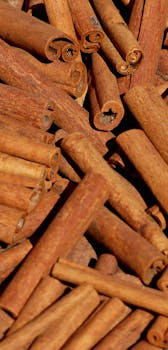Benefits
Blood Sugar Management
Heart Disease Risk Reduction
Anti-inflammatory Properties
Antimicrobial Effects
Aromatherapy and Stress Relief
Get creative with additional cinnamon
Sprinkling additional cinnamon on top of your morning latte or cappuccino for a warm and spicy twist
Mixing it into homemade granola for an extra layer of flavor that pairs wonderfully with the oats and nuts
Creating a cinnamon-infused honey by stirring the spice into warm honey, perfect for drizzling over biscuits or adding to tea
Adding a pinch to savory dishes like stews, chili, or tomato sauces to add depth and a slight sweetness that complements the other ingredients beautifully
Incorporating it into your smoothie or oatmeal for a natural sweetener that also boosts the health benefits of your meal, from anti-inflammatory properties to blood sugar regulation
Something you can make with additional cinnamon
Origin
Cinnamon is a spice that has been used for thousands of years and has a rich history. It is derived from the bark of trees belonging to the Cinnamomum genus, primarily Cinnamomum verum or Cinnamomum cassia. \n\nThe origin of cinnamon can be traced back to ancient Egypt, where it was highly valued and used in embalming rituals. It was also used in cooking and as a fragrance. Cinnamon was considered a luxury item and was often traded along the famous spice routes of the ancient world.\n\nCinnamon later spread to other parts of the world, including the Middle East, Europe, and Asia. It became an important ingredient in various cuisines and was used for its distinct flavor and aroma. In many cultures, cinnamon is associated with warmth and comfort, and it is often used in desserts, baked goods, and hot beverages.\n\nToday, cinnamon is grown in several countries, including Sri Lanka, Indonesia, China, Vietnam, and India


